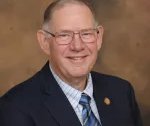To the Editor:
Having family at Great Bend and throughout Barton County, I’ve visited my share of cemeteries. I marvel at the Great Bend Cemetery, which was started in the late 1870s but I was told has some transplanted (or re-interred) graves dating back to 1866. Amazing. Roughly, just five years after Kansas’s statehood. I am impressed by the St. Ann’s Catholic Cemetery in Olmitz; and the Saint John the Evangelist Catholic Cemetery in Hoisington. I regard all such places as serene and sacred; comparable to a crucifix. How many of us think of how we will be remembered?
Most people like the sight of a well-manicured cemetery. Sadly, most people only visit around Memorial Day, if ever. One man who was described as the best cemetery landscaping architect ever was Adolph Strauch (1822-1883). He developed what is known as the “landscape-lawn plan” in which he envisioned cemeteries with tasteful headstones which blended nicely into the God given scenery of the earth.
Although he lived in Ohio, Strauch was sought-out for advice in many States, including Texas. He was even consulted for the prestigious Crown Hill Cemetery in Indianapolis, Ind. (which I have seen myself). It is the third-largest non-governmental cemetery in the United States.
Adolph Strauch was Superintendent of Spring Grove Cemetery in Cincinnati, Ohio. He died at the young age of 60. He was a longtime member of Hoffner Masonic Lodge and was the very first member of Hanselmann Commandery of the York Rite after it was established in 1869.
Strauch even laid-out his own cemetery plot. When he died, the remains were embalmed promptly and the body placed in a casket, over which was a Masonic plate engraved with his name and lifespan years. A contemporary 1883 account, says: “....the remains were attired in the full Templar uniform with the decoration of the Order upon the peaceful breast. The chapeau (hat) and Templar ceremonial sword, a collection of calla lilies, lay upon the coffin...” The lid was shut and the casket carried by seven pallbearers, including the famous Enoch T. Carson. The casket was loaded upon a catafalque. The Episcopal Service for the dead was performed by Rev. Rowland.
Cemeteries offer us a sanctuary of repose and peace for the honored Dead. Adolph Strauch believed in “Landmarks” of our lives for posterity’s sake. Up until 1963, the Roman Catholic Church even disallowed cremation. It allows it now, provided that the ashes are deposited in a cemetery or container in a holy place (not at home).
Some of the best cemeteries I have seen are Blue Springs Cemetery in Blue Springs, Neb. (the oldest recorded cemetery in Nebraska); Greenwood Cemetery in Franklin, Neb.; Calvary Cemetery in Wichita, Kan.; Saint Elizabeth’s Catholic Cemetery in Esbon, Kan.; and Mt. Moriah Cemetery in Deadwood, South Dakota. Tombstones, markers, cenotaphs, monuments, fountains, statues and obelisks are all majestic. One of the most unique, yet somewhat austere cemeteries that visited was where my great grandfather Rudolf Riedl was buried in 1940 in Basin, Wyo., in Mount View Cemetery. His tombstone is literally a huge boulder with the name “Riedl” inscribed therein. To say it looked ”stark” would be an understatement, yet, I have respect for the honored dead. Perhaps, my great grandpa was eccentric or eclectic? This is a free country.
Another great grandfather, Wilhelm Hampel is buried at Great Bend Cemetery. Our military places great emphasis on retrieving dead bodies of dead American soldiers for a reason – Respect! Adolph Strauch deserves plenty of respect.
James A. Marples
Esbon



